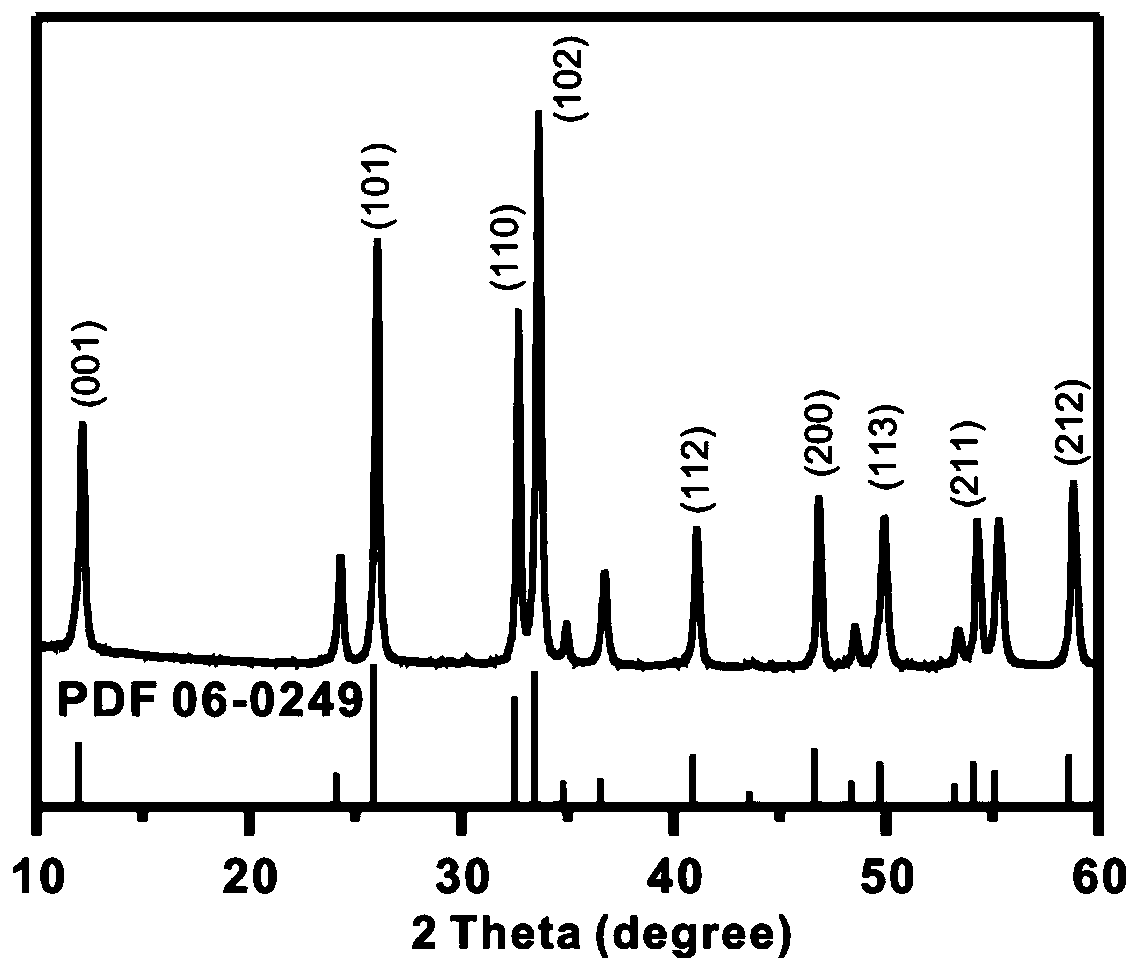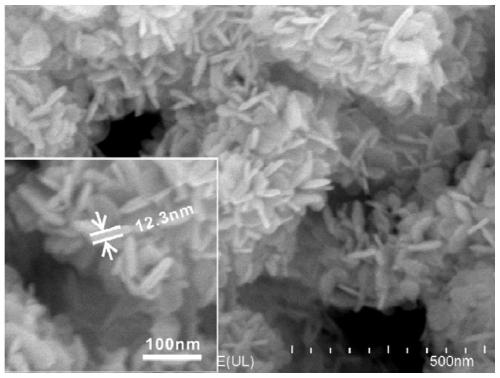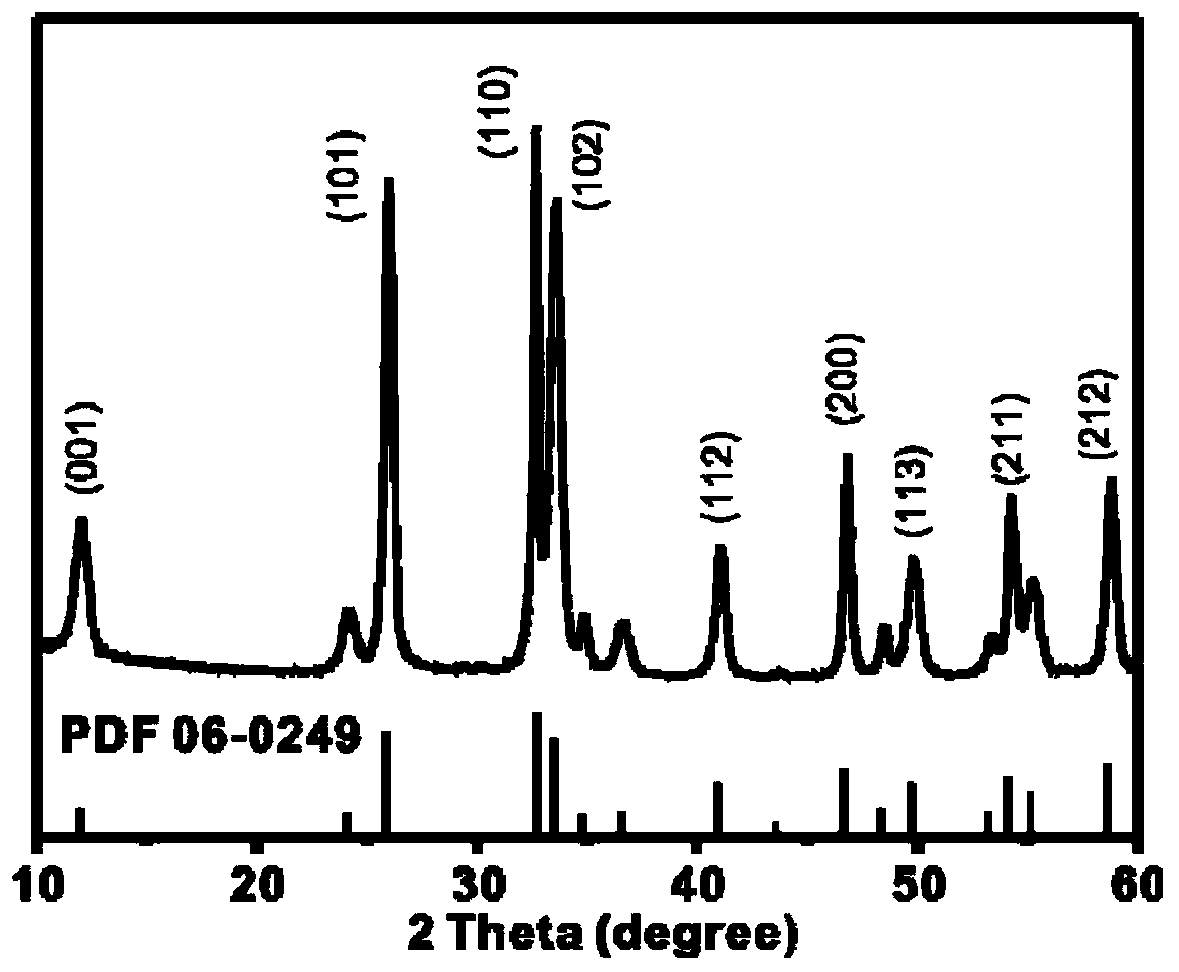Method for preparing BiOX nanosheets at room temperature in one step
A bismuth oxyhalide nanometer, room temperature technology, applied in chemical instruments and methods, inorganic chemistry, bismuth compounds, etc., to achieve the effects of controllable species, high application prospects, and low equipment requirements
- Summary
- Abstract
- Description
- Claims
- Application Information
AI Technical Summary
Problems solved by technology
Method used
Image
Examples
Embodiment 1
[0035] Step (1), at room temperature of 20°C, dissolve 2mmoL of bismuth nitrate pentahydrate in ethylene glycol, so that the concentration of bismuth element is 80mM, sonicate for 5min until the soluble bismuth salt is completely dissolved, and obtain a transparent solution A;
[0036] Step (2), at room temperature of 20°C, dissolve 2mmoL potassium chloride in deionized water so that the concentration of potassium chloride is 400mM, sonicate for 5-10min until the soluble halide salt is completely dissolved to obtain a transparent solution B;
[0037]Step (3), at room temperature 20°C, under stirring conditions, add solution B dropwise to solution A to form suspension C, wherein the atomic ratio of Cl element to Bi element in the suspension is 1: 1;
[0038] Step (4), after stirring the above mixture C for 1 h, centrifuge, wash with deionized water and absolute ethanol successively, after each washing 3 to 4 times, place the obtained product in an oven at 80°C for 24 h to obtai...
Embodiment 2
[0040] Step (1), at room temperature of 20°C, dissolve 2mmoL of bismuth nitrate pentahydrate in ethylene glycol so that the concentration of bismuth element is 240mM, and ultrasonicate for 5min until the soluble bismuth salt is completely dissolved to obtain a transparent solution A;
[0041] Step (2), at room temperature of 20°C, dissolve 2mmoL potassium chloride in deionized water so that the concentration of potassium chloride is 240mM, sonicate for 5-10min until the soluble halide salt is completely dissolved, and a transparent solution B is obtained;
[0042] Step (3), at room temperature 20°C, under stirring conditions, add solution B dropwise to solution A to form suspension C, wherein the atomic ratio of Cl element to Bi element in the suspension is 1: 1;
[0043] Step (4), after stirring the above mixture C for 1 h, centrifuge, wash with deionized water and absolute ethanol successively, after each washing 3 to 4 times, place the obtained product in an oven at 80°C fo...
Embodiment 3
[0045] Step (1), at room temperature of 20°C, dissolve 2mmoL of bismuth nitrate pentahydrate in ethylene glycol so that the concentration of bismuth element is 400mM, sonicate for 5min until the soluble bismuth salt is completely dissolved to obtain a transparent solution A;
[0046] Step (2), at room temperature of 20°C, dissolve 2mmoL of potassium chloride in deionized water so that the concentration of potassium chloride is 80mM, and sonicate for 5-10min until the soluble halide salts are completely dissolved to obtain a transparent solution B;
[0047] Step (3), at room temperature 20°C, under stirring conditions, add solution B dropwise to solution A to form suspension C, wherein the atomic ratio of Cl element to Bi element in the suspension is 1: 1;
[0048] Step (4), after stirring the above mixture C for 1 h, centrifuge, wash with deionized water and absolute ethanol successively, after each washing 3 to 4 times, place the obtained product in an oven at 80°C for 24 h t...
PUM
| Property | Measurement | Unit |
|---|---|---|
| thickness | aaaaa | aaaaa |
| thickness | aaaaa | aaaaa |
| thickness | aaaaa | aaaaa |
Abstract
Description
Claims
Application Information
 Login to View More
Login to View More - R&D
- Intellectual Property
- Life Sciences
- Materials
- Tech Scout
- Unparalleled Data Quality
- Higher Quality Content
- 60% Fewer Hallucinations
Browse by: Latest US Patents, China's latest patents, Technical Efficacy Thesaurus, Application Domain, Technology Topic, Popular Technical Reports.
© 2025 PatSnap. All rights reserved.Legal|Privacy policy|Modern Slavery Act Transparency Statement|Sitemap|About US| Contact US: help@patsnap.com



